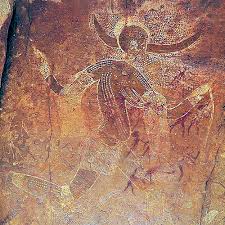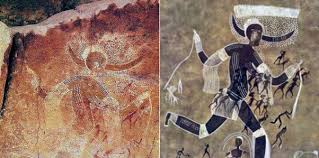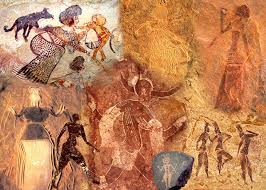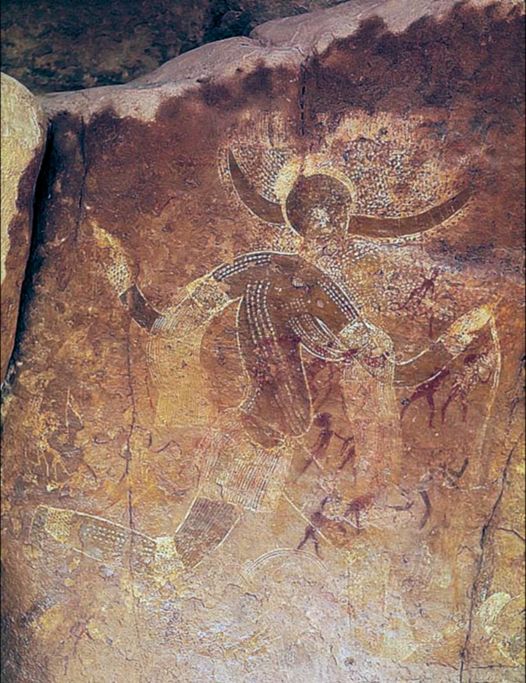In the remote and awe-inspiring Tassili n’Ajjer plateau of Algeria, a remarkable piece of ancient rock art has captivated the imaginations of archaeologists, historians, and curious minds alike. Known as the “Running Horned Woman,” this dynamic depiction, dating back to between 6,000 and 4,000 BC, offers a tantalizing glimpse into the spiritual and cultural world of the region’s earliest inhabitants.
Discovered in the 1930s by a French Foreign Legion officer and later popularized by renowned archaeologist Henri Lhote, this enigmatic figure has become a symbol of the rich artistic heritage of the Tassili n’Ajjer, a UNESCO World Heritage site that boasts over 15,000 rock paintings. As we delve into the mysteries surrounding this intriguing artwork, we’ll uncover the stories it holds and explore the insights it provides into the lives and beliefs of the ancient peoples who once called this breathtaking landscape home.
The Tassili n’Ajjer: A Landscape of Timeless Wonders

The Tassili n’Ajjer plateau, situated in the heart of the Sahara Desert, is a truly remarkable and awe-inspiring place. Once a lush, verdant region teeming with abundant wildlife, this vast, rugged landscape has been transformed over millennia into a stark, otherworldly terrain of towering sandstone formations, deep canyons, and sweeping vistas.
Yet, despite the harsh, arid conditions that now dominate the Tassili n’Ajjer, the region has been a hub of human activity and artistic expression for thousands of years. The plateau’s rock shelters and overhanging cliffs have served as canvases for the remarkable artworks of the region’s ancient inhabitants, who left behind a stunning visual record of their lives, beliefs, and interactions with the natural world.
Uncovering the “Running Horned Woman”

The “Running Horned Woman” is one of the most captivating and enigmatic of the Tassili n’Ajjer’s rock art treasures. Discovered in the 1930s by French Foreign Legion officer Lieutenant Brenans, the image was brought to light by the simple act of wetting the rock surface, revealing a dynamic, almost lifelike figure adorned with horns and fringes.
In the 1950s, the image was further popularized by the renowned archaeologist Henri Lhote, who recognized the profound significance of this remarkable artwork. Lhote’s extensive explorations of the Tassili n’Ajjer plateau led to the discovery of over 15,000 rock paintings, each offering a unique window into the lives and beliefs of the region’s earliest inhabitants.
The Symbolism and Significance of the “Running Horned Woman”
The “Running Horned Woman” has captivated the imaginations of scholars and enthusiasts alike, with much debate and speculation surrounding the meaning and significance of this intriguing figure. The horns adorning the woman’s head have been the subject of particular interest, with many scholars suggesting that they may symbolize a connection to domestic cattle or a ritualistic role within the society.

Some researchers have proposed that the horns may have represented a connection to the divine or a link between the human and the spiritual realms. The dynamic, almost frenzied pose of the figure has also led to suggestions that she may have been engaged in a ceremonial dance or other ritual activity, perhaps in the context of agricultural or fertility rites.
Interestingly, the “Running Horned Woman” was initially thought to have been influenced by foreign artistic traditions, with some scholars proposing that the artwork may have been inspired by Egyptian or Mesopotamian influences. However, as our understanding of the Tassili n’Ajjer’s rich cultural heritage has deepened, the consensus among experts is that these remarkable artworks are the indigenous creations of the region’s ancient African peoples.
The Tassili n’Ajjer: A UNESCO World Heritage Site

The Tassili n’Ajjer plateau, with its wealth of rock art and archaeological treasures, was recognized as a UNESCO World Heritage site in 1982. This prestigious designation underscores the global significance of this remarkable region, which serves as a testament to the enduring creativity, ingenuity, and spiritual beliefs of the ancient peoples who once called this place home.
Today, the Tassili n’Ajjer continues to captivate and inspire visitors from around the world, who come to marvel at the stunning natural landscapes and to unravel the mysteries of the region’s rich artistic and cultural heritage. From the “Running Horned Woman” to the countless other rock art masterpieces that dot the plateau, the Tassili n’Ajjer remains a place of profound wonder and discovery, inviting us to step back in time and connect with the timeless stories of our shared human past.
Conclusion
The “Running Horned Woman” of the Tassili n’Ajjer plateau is a testament to the enduring power of art to captivate, inspire, and reveal the stories of our shared human experience. As we continue to explore and unravel the mysteries surrounding this remarkable artwork, we are granted a glimpse into the lives, beliefs, and cultural traditions of the ancient peoples who once inhabited this breathtaking landscape.
Whether the horns symbolize a connection to the divine, a ritual role within the society, or some other profound meaning, the “Running Horned Woman” remains a captivating and enigmatic figure, inviting us to ponder the rich tapestry of human history and the enduring power of artistic expression to bridge the divide between past and present. As we delve deeper into the wonders of the Tassili n’Ajjer, may we be inspired to continue uncovering the secrets of this remarkable place and to celebrate the timeless artistry and cultural heritage of our ancestors.
Perspective through video
